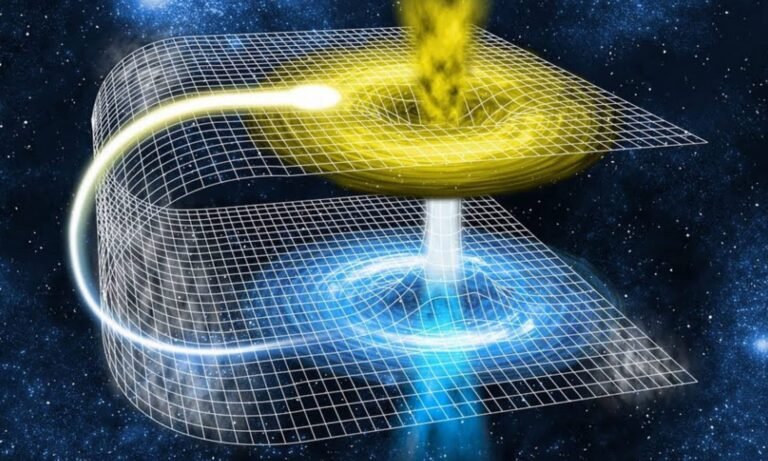Black holes are fascinating celestial phenomena that arise when massive stars exhaust their nuclear fuel and undergo a cataclysmic collapse. The remnants of these stars, following a supernova explosion, can create a region in space where the gravitational pull is so intense that nothing – not even light – can escape. This characteristic gives black holes their name, which is derived from their ability to obscure light and other forms of radiation from reaching an observer.
At the heart of a black hole lies a singularity, a point where gravity is theorized to become infinite. Surrounding this singularity is the event horizon, a boundary beyond which nothing can escape the gravitational grasp of the black hole. To visualize this, one might imagine a whirlpool where currents pull everything towards the center; once objects cross the event horizon, they are inevitably drawn into the singularity, never to return. This stark division between the interior and exterior of a black hole illustrates a fundamental characteristic that distinguishes them from other celestial bodies, such as stars or planets, which do not possess such extreme gravitational fields.
There are primarily three types of black holes recognized in astrophysics: stellar black holes, formed from the remnants of massive stars; supermassive black holes, located at the centers of galaxies and containing millions to billions of times the mass of the sun; and intermediate black holes, whose existence remains more hypothetical. Each type exhibits unique properties and effects on their surrounding environments, playing a significant role in the evolution of galaxies and the behavior of matter in the universe.
Understanding black holes challenges our assumptions about space, time, and gravity, pushing the boundaries of human knowledge while igniting curiosity about the cosmos. As research into these enigmatic objects continues, we are gradually uncovering the mysteries they hold and their implications for our understanding of the universe.
Types of Black Holes
Black holes are fascinating cosmic entities that vary in size and formation processes. They can be categorized into three primary types: stellar black holes, supermassive black holes, and intermediate black holes. Each type possesses distinct characteristics and plays a unique role in the universe.
- Stellar black holes are formed from the remnants of massive stars that have undergone gravitational collapse after exhausting their nuclear fuel. Typically, these black holes range in mass from about 3 to several tens of solar masses. They are commonly found in regions with high stellar density, such as globular clusters or the remnants of supernovae. An example of a notable stellar black hole is V404 Cygni, known for its periodic outbursts of X-rays, showcasing the intriguing interactions between the black hole and its companion star.
- Supermassive black holes, on the other hand, are significantly larger, with masses ranging from millions to billions of solar masses. These gargantuan black holes are typically located at the centers of galaxies, including our own Milky Way, which houses Sagittarius A*, the supermassive black hole that weighs approximately four million solar masses. Their formation remains a subject of research, with prevailing theories suggesting they could form through the merging of smaller black holes or the direct collapse of massive gas clouds in the early universe. Supermassive black holes profoundly influence their surroundings, affecting star formation and the dynamics of entire galaxies.
- Intermediate black holes occupy a less understood category, with masses ranging from hundreds to thousands of solar masses. Their existence has been inferred from gravitational wave signals and observational evidence in dense star clusters. Although fewer examples exist compared to other types, some candidates such as the black hole in the star cluster ESO 243-49 HLX-1 have provided valuable insights into their formation and role in cosmic evolution.
The Role in the Universe
Black holes are more than just enigmatic cosmic phenomena; they play a vital role in shaping the universe as we know it. Their influence extends beyond their immediate surroundings, affecting the formation and evolution of galaxies. As regions of intense gravitational pull, black holes serve as anchor points around which galaxies can form. The process begins with gas and dust collapsing under their own gravity, eventually leading to star formation and the creation of complex structures within the galaxy.
Central to the dynamics surrounding black holes is the phenomenon of accretion disks. These disks form as matter from nearby stars and gas clouds spirals inward toward the black hole, creating a rotating, flat structure. As material in the accretion disk accelerates, it heats up due to friction and gravitational forces, emitting enormous amounts of energy, which can often outshine entire galaxies. This powerful energy release not only affects its immediate vicinity but can impact star formation rates and the distribution of matter in the galaxy, fostering a complex interplay between black holes and their environments.
Black holes influence the movement and evolution of nearby stars and gas clouds, beyond their role in energy emissions. Their immense gravity alters stellar trajectories, causing interactions like tidal disruptions. Stars straying too close can be torn apart, revealing deep insights into both stars and black holes. Their role in shaping galaxies also raises profound questions about the universe’s formation.
Beyond their influence on cosmic structures, black holes serve as laboratories for understanding the laws of physics under extreme conditions. Studying their properties and behavior enables scientists to probe theories of general relativity, quantum mechanics, and the fundamental nature of matter and energy. As researchers continue to unlock the mysteries surrounding black holes, our comprehension of the universe deepens, highlighting the intricate connections that bind galaxies and their enigmatic inhabitants.
Current Research and Theories
Black holes, once considered mere theoretical constructs, have become focal points of contemporary astrophysical research. Recent advances in observational techniques have allowed scientists to gather substantial evidence supporting their existence and characteristics. The identification of gravitational waves, first detected in 2015 by the LIGO observatory, has provided new means to study black holes, specifically the events resulting from their mergers. This groundbreaking discovery not only confirmed a fundamental prediction of Einstein’s General Theory of Relativity but also opened a new observational window into the cosmos.
Within the scientific community, there is ongoing debate regarding several unresolved questions related to black holes. One prominent issue is the “information paradox,” which arises from the apparent conflict between quantum mechanics and general relativity. As matter falls into a black hole, the question persists: does the information contained within it become irretrievably lost? This paradox has provoked various theories, including suggestions that information may be preserved at the event horizon or dispersed through Hawking radiation, introducing complexity to our understanding of quantum gravity.
As we look to the future, the possibilities for black hole research appear boundless. Upcoming missions and advancements in technology promise to enhance our capacity to observe and interpret these enigmatic entities. Initiatives such as the Event Horizon Telescope aim to capture images of black hole silhouettes, while new gravitational wave detectors are set to increase our understanding of cosmic phenomena. The continuous unraveling of black hole mysteries carries the potential to reshape our comprehension of the universe, highlighting the profound complexities of astrophysics.
What’s More
The posts in My Blog feature reflective, story-driven pieces rooted in personal and societal insights.
The topics in My Interests explore abstract, philosophical ideas and their cultural and societal impact.
👁️ 6,382 Views













